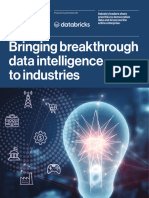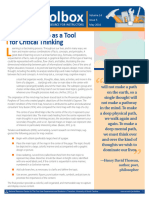aL;f}+ jflif{sf]T;j :dfl/sf @)*)
20th Anniversary Souvenir 2024
Personalized Marketing: Recommend enhances overall IoT device management, ensuring
mobile plans, data packages, and value-added efficiency and reliability in the evolving telecom
services based on individual customer usage patterns infrastructure.
and preferences, increasing customer satisfaction
2.6 Data services for SMEs
and revenue.
Telecom operators amass a gold mine of
2.3 AI driven customer service and care
customer behaviour data. By performing exploratory
management
data analytics, telecom companies can gain valuable
Chatbots provide automated 24/7 responses to insights into customer behaviours, preferences, and
customer queries, improving the efficiency of usage patterns. By aggregating such data within a
customer support. Call centres can be automated by geographic region one can estimate in advance the
utilizing chatbot agents. Similarly, customer service potential uptake of new products, services,
queries via email/SMS/instant messaging can be restaurants, real estate etc. Such data can be provided
handled by chatbots. Integrated solutions can be to SMEs to help them identify geographic regions
developed where customer relationship and products that will have a high chance of success.
management is largely handled by AI. Personalized
concierge services can be provided by chatbots. 2.7 GPU, Cloud and AI Computing
Infrastructure
2.4 Fraud Detection and Security
Every region, every industry sector is grappling
Machine learning algorithms are developed to
with the push into AI driven computing. As a result,
analyze telecom systems possessing extensive real-
there is an ever-increasing demand for GPU
time data, facilitating the identification of irregular
computing cloud infrastructure. Telcos can take
patterns and potential fraudulent behaviours. Whether
advantage of this demand by installing rack servers
dealing with SIM card cloning, subscription fraud, or
unauthorized access attempts, the predictive analytics
can rapidly identify and thwart fraudulent activities.
AI and machine learning contribute by
establishing automatic responses when specific
events are detected. This not only results in cost
savings for implementation and maintenance but
also simplifies the overall architecture. The
integration of fraud prevention mechanisms utilizing
the same real-time data as other processes not only
streamlines operations but, most importantly,
ensures a novel and intelligent approach to securing
business operations.
2.5 IoT Management
As the number of interconnected devices grows
in the Internet of Things (IoT), managing this
complex system becomes vital. AI provides
intelligent solutions for effective IoT management
within the telecom industry. AI algorithms process together with both CPU and GPU compute. They
and interpret massive amounts of data generated by already have their own infrastructure for internal
IoT devices, optimizing network performance and usage. Both national and international markets can
facilitating seamless integration. This capability be served.
41
� aL;f}+ jflif{sf]T;j :dfl/sf @)*)
20th Anniversary Souvenir 2024
2.8 Gaming and entertainment services 3. AI Transformation process
AI transformation is the process of
implementing AI and machine learning to bring
about fundamental changes in the operations,
decision-making processes, and overall value
delivery of an organization. It involves embedding
AI into the system, influencing everything from
strategy and decision-making to customer
experience and operational efficiency. As per the
AI Transformation Playbook (landing.ai), although
Online data usage is increasing exponentially the complete AI transformation process may take
as people increasingly move to a connected and 2-3 years, organizations can start experiencing
online world. People are spending more time on returns on their investment within the initial 6 to 12
online entertainment and online games. There is an months.
increased demand for gaming and entertainment
3.1 Telcom Audit
services. Local hosting of these within a cloud
infrastructure reduces internet costs and reduces Telecom audits are an indispensable tool in the
latency. This in turn increases user satisfaction and telecom industry as it plays a vital role in uncovering
causes increased demand. There is ample challenges and inefficiencies inherent in legacy
opportunities for the telecom industry to tap into communication systems. These comprehensive
this market by forging partnerships with popular assessments are in-depth examination of the existing
gaming providers and entertainment providers. infrastructure. The audit process meticulously
examines the hardware, software, network
2.9 Managed AI services architecture, revealing inefficiencies that may hinder
optimal performance.
A key focus of telecom audits lies in addressing
interoperability challenges within the
telecommunications infrastructure. As technology
advances, ensuring compatibility with new
innovations, such as AI technologies, becomes
imperative. Telecom audits systematically evaluate
interoperability issues, ensuring that the existing
systems can seamlessly integrate with emerging
technologies.
Data lake and data warehouse systems can be
developed as a pre-step to wider AI adoption. These
become feasible once interoperability issues and data
bridges across disparate telecom systems have been
AI manages services such as those provided by
established.
Amazon, Azure and Google are a first choice when
it comes to quick prototyping of a new AI product. 3.2 Organizational Readiness for AI
Additionally, many companies choose to keep using Transformation
these services even after commercial deployment Transforming an organization towards
as long as this meets their overall operational costs. becoming AI and data-driven is more about factors
Such services can be offered by Telcos by forming beyond the AI technology itself. Key elements
partnerships or choosing open-source models such include: a) the organization's AI expertise, b)
as Hugging face. comprehension of organizational data sources, c)
42
� aL;f}+ jflif{sf]T;j :dfl/sf @)*)
20th Anniversary Souvenir 2024
implementation of secure data access mechanisms, comprehending the structural transformation needed
d) ensuring data quality, e) organizational readiness, within the organization. The organization risks
and f) allocation of human and computational overhyping the adopted AI technology, if the AI
resources.
adoption succeeds, it empowers the organization to
Organizations often tend to treat AI systems as take on additional black box projects whilst the
typical software, leading to significant discrepancies failure of AI adoption leads to a potential total
between the expected quality of service delivery,
shutdown of AI adoption. Neither of these situations
the effort invested in system customization and
is ideal and indicates organizational immaturity. It
monitoring, and the complexity/quality of the
deployed AI system. Customers frequently anticipate is worth noting that, according to various studies
AI systems to perform flawlessly, akin to portrayals and whitepapers, over 80% of AI black box projects
in sci-fi movies, while vendors may oversell their have failed. The key reasons for failure include:
relatively simplistic AI systems.
Over hype and over expectation of AI
AI systems, such as generative AI systems, are capabilities;
stochastic in nature, meaning they do not necessarily
produce the same output given similar inputs. This Limited understanding of the brittleness of
makes testing such AI systems and providing a AI technology;
guaranteed quality of service much harder.
Limited effort (both time and money) spent
Additionally, AI systems are inherently brittle; slight
in adapting/fine tuning the deployed AI
perturbations in the input can lead to drastically
different behaviour. When the input data distribution system;
of the deployed system is sufficiently different from Limited continuous monitoring and
the training data distribution, the performance and adaptation.
accuracy of the AI system do not degrade gracefully.
Instead, the AI system’s output becomes highly Active:
unreliable or incorrect. This behaviour is drastically Initial experimentation with data science projects
different from that of existing software systems. is initiated during this stage. The organization
Often, early providers of AI systems come from develops an understanding of its own data, how it
a software engineering/IT background. They can be employed in initial data science projects, and
typically lack the know-how or maturity in AI
discovers, in this process, gaps in its data. An initial
system deployment and management, leading to
eventual failures in long-term usage. data science and analytics team is formed, and senior
management realizes the value of this team.
Following Gartner’s maturity model1, one can
distinguish AI readiness and maturity in AI adoption Operational:
within an organization. The different stages of Both data-driven decision-making (DDDM) and
organizational AI maturity are: predictive analytics are actively employed within
Awareness: the organization. An efficient data warehouse is
The organization embarks on early AI adoption developed that is connected to a real-time DDDM
during this stage. Specifically, the organization and predictive analytics platform. The organization
dabbles in AI technology without fully embarks on regular training and up-skilling of its
understanding it. Some AI black box projects are workforce to ensure that business decisions are
initiated at this stage without necessarily informed by data and quantitative predictions.
Data analytics and AI-driven predictions are now
1
https://www.gartner.com/smarterwithgartner/the-cios-
main stream within the organization.
guide-to-artificial-intelligence
43

































































































